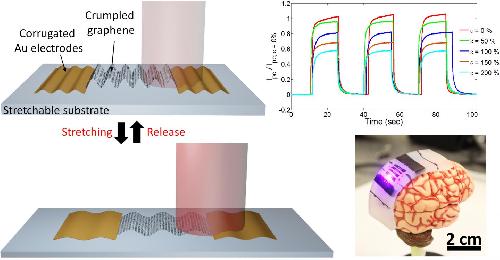Researchers from the University of Illinois at Urbana-Champaign have demonstrated a new approach to modifying the light absorption and stretchability of atomically thin two-dimensional (2D) materials by surface topographic engineering using only mechanical strain. The highly flexible system has future potential for wearable technology and integrated biomedical optical sensing technology when combined with flexible light-emitting diodes.
"Increasing graphene's low light absorption in visible range is an important prerequisite for its broad potential applications in photonics and sensing," explained SungWoo Nam, an assistant professor of mechanical science and engineering at Illinois. "This is the very first stretchable photodetector based exclusively on graphene with strain-tunable photoresponsivity and wavelength selectivity."
Graphene--an atomically thin layer of hexagonally bonded carbon atoms--has been extensively investigated in advanced photodetectors for its broadband absorption, high carrier mobility, and mechanical flexibility. Due to graphene's low optical absorptivity, graphene photodetector research so far has focused on hybrid systems to increase photoabsorption. However, such hybrid systems require a complicated integration process, and lead to reduced carrier mobility due to the heterogeneous interfaces.
 Stretchable photodetector with enhanced, strain-tunable photoresponsivity was created by engineering the 2-D graphene material into 3-D structures, increasing the graphene's areal density. Credit: SungWoo Nam, University of Illinois
Stretchable photodetector with enhanced, strain-tunable photoresponsivity was created by engineering the 2-D graphene material into 3-D structures, increasing the graphene's areal density. Credit: SungWoo Nam, University of Illinois
According to Nam, the key element enabling increased absorption and stretchability requires engineering the two-dimensional material into three-dimensional (3D) "crumpled structures," increasing the graphene's areal density. The continuously undulating 3D surface induces an areal density increase to yield higher optical absorption per unit area, thereby improving photoresponsivity. Crumple density, height, and pitch are modulated by applied strain and the crumpling is fully reversible during cyclical stretching and release, introducing a new capability of strain-tunable photoabsorption enhancement and allowing for a highly responsive photodetector based on a single graphene layer.
"We achieved more than an order-of-magnitude enhancement of the optical extinction via the buckled 3D structure, which led to an approximately 400% enhancement in photoresponsivity," stated Pilgyu Kang, and first author of the paper, "Crumpled Graphene Photodetector with Enhanced, Strain-tunable and Wavelength-selective Photoresponsivity," appearing in the journal, Advanced Materials. "The new strain-tunable photoresponsivity resulted in a 100% modulation in photoresponsivity with a 200% applied strain. By integrating colloidal photonic crystal--a strain-tunable optomechanical filter--with the stretchable graphene photodetector, we also demonstrated a unique strain-tunable wavelength selectivity."
"This work demonstrates a robust approach for stretchable and flexible graphene photodetector devices," Nam added. "We are the first to report a stretchable photodetector with stretching capability to 200% of its original length and no limit on detection wavelength. Furthermore, our approach to enhancing photoabsorption by crumpled structures can be applied not only to graphene, but also to other emerging 2D materials."
source: University of Illinois College of Engineering